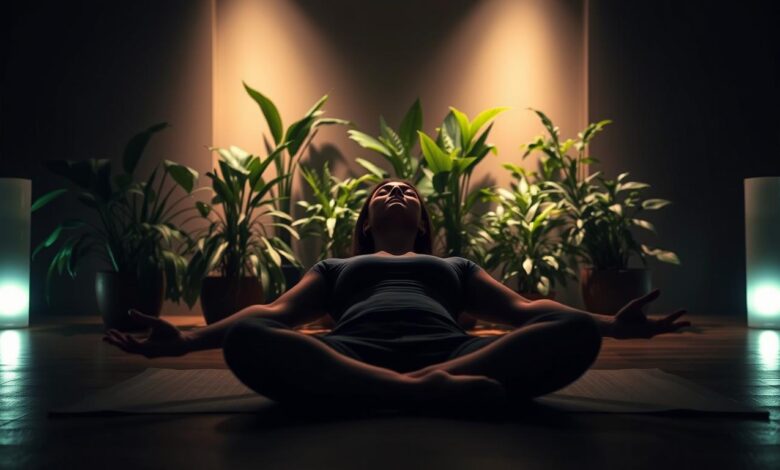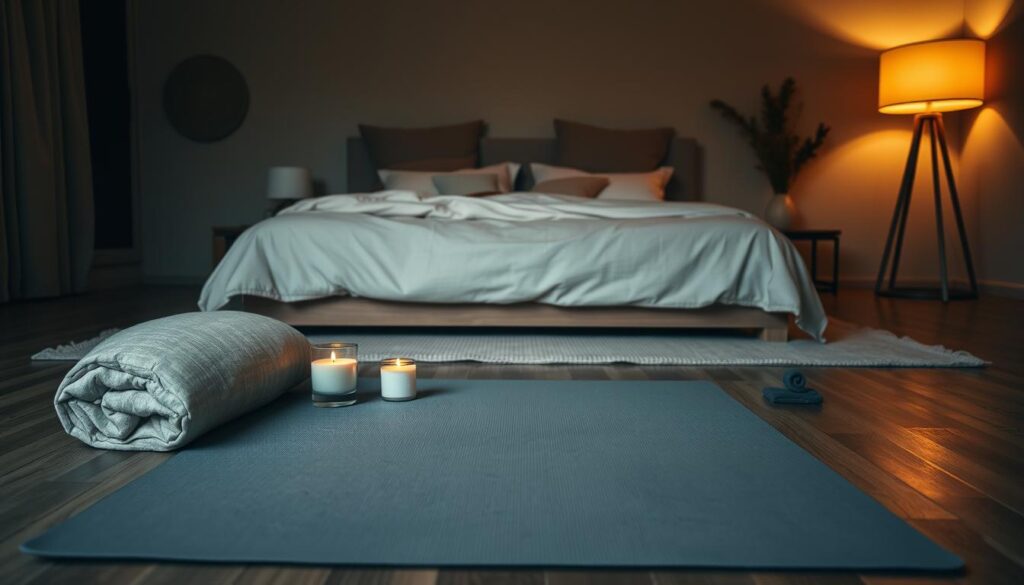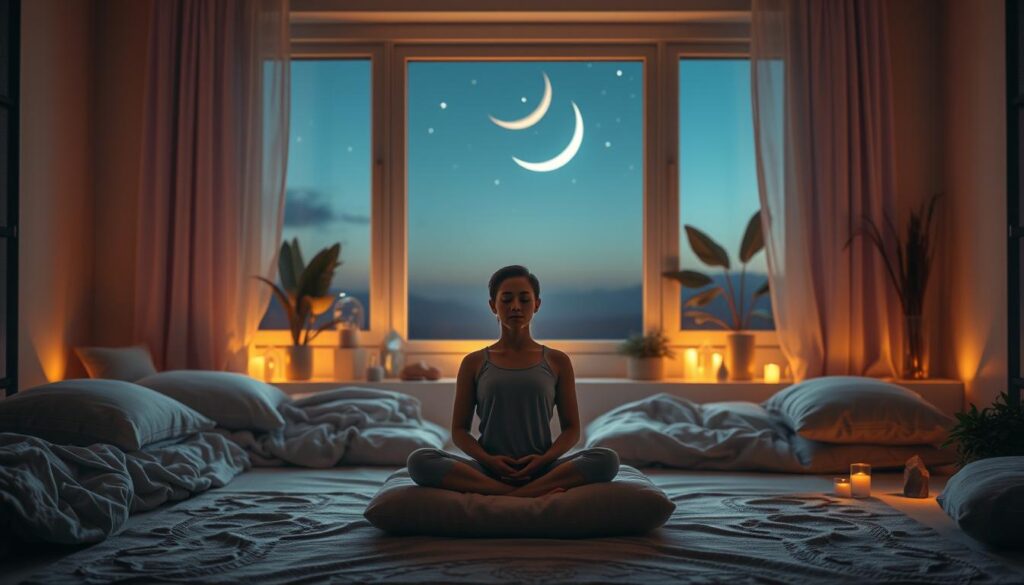
Unlock the Secret to Better Sleep with Yoga Nidra
Are you tired of counting sheep but still lying awake? Modern life’s stress and screen-filled nights leave millions struggling—35% of adults in the U.S. don’t get enough sleep. Yoga Nidra, an ancient practice, offers a proven escape. This guided relaxation technique combines mindfulness and breathwork to quiet the mind and restore rest. Science backs it too: studies show it lowers stress hormones like cortisol, easing the path to sleep.

Yoga nidra benefits go beyond theory. No yoga mat or prior experience is needed—just a quiet space. This article reveals how to use yoga nidra for better sleep through simple steps, proven techniques, and real-world success stories. Discover how 20-minute sessions can reset your sleep cycle, calm anxiety, and deepen rest naturally.
Key Takeaways
- Yoga Nidra reduces insomnia and improves sleep quality through guided relaxation.
- Over 35% of Americans face sleep deprivation, but this practice offers a natural solution.
- No prior yoga experience is required to start benefiting from yoga nidra.
- Scientific research links yoga nidra to lower cortisol levels and better sleep cycles.
- Learn actionable steps to integrate this practice into daily routines for long-term results.
What is Yoga Nidra and How Does It Work?
Yoga Nidra, often called “yogic sleep,” is a profound deep relaxation technique rooted in ancient Indian traditions. Unlike meditation or regular sleep, this practice guides you into a state of conscious relaxation while remaining aware. Modern adaptations now offer structured sessions accessible to all, blending tradition with science.
Understanding the Basics of Yoga Nidra
A typical session involves lying comfortably while a guide leads you through body scans, breath awareness, and visualization. Here’s how it unfolds:
- Initial relaxation to release physical tension
- Breath focus to steady the mind
- Visualization to deepen mental stillness
These steps create a gateway to the subconscious, making it distinct from other deep relaxation techniques.
The Science Behind Sleep and Relaxation
Research shows Yoga Nidra slows brainwaves from active beta to slower theta waves, similar to the onset of sleep. This shift triggers the parasympathetic nervous system, reducing stress hormones like cortisol. A 2020 study in Frontiers in Human Neuroscience noted participants had 23% better sleep quality after regular practice. By boosting melatonin naturally, these yoga nidra benefits align with the body’s natural sleep rhythms.
“The brainwave changes during Yoga Nidra mirror the restorative phases of deep sleep.” — Dr. Richard Brown, Columbia University
Benefits of Yoga Nidra for Sleep Improvement
Yoga nidra is a powerful tool to improve sleep quality through yoga nidra. By calming the mind and relaxing the body, this practice tackles common barriers to restful sleep. Research shows it can reset the body’s stress response, making it easier to fall asleep and stay asleep.

Reducing Insomnia and Sleep Anxiety
Insomnia often stems from a racing mind or physical tension. Yoga nidra uses guided awareness techniques to slow thoughts and release muscle stiffness. A 2022 study in the Journal of Sleep Disorders & Therapy found participants saw a 34% drop in nighttime wake-ups after 4 weeks of regular practice. By focusing on breath and body scans, it shifts the nervous system from “fight or flight” to a relaxed state, reducing anxiety around bedtime.
Enhancing Sleep Quality and Duration
Regular sessions boost enhanced sleep patterns through yoga nidra by extending deep sleep stages. These phases are critical for tissue repair and memory consolidation. Key benefits include:
- Increased time spent in REM sleep for emotional balance
- Stabilized circadian rhythms through melatonin regulation
- Shorter time to fall asleep (sleep latency reduction)
“Yoga nidra doesn’t just make you tired—it teaches your body to recognize and sustain natural sleep cycles.” — Dr. Sarah Chen, Sleep Medicine Specialist
These changes aren’t temporary. Consistent practice builds long-term resilience against stress-induced sleep disruptions, creating a foundation for healthier rest night after night.
How to Practice Yoga Nidra for Better Sleep
Mastering how to practice yoga nidra for better sleep starts with small, intentional steps. Whether you’re a beginner or looking to refine your routine, these guidelines help create a personalized path to restful nights.
Finding the Right Time for Practice
Timing matters. Many find practicing guided meditation for sleep 30–60 minutes before bed most effective, but mornings or midday sessions can also build “sleep deposits” by reducing daily stress. Experiment with different times to see what aligns with your body’s rhythm. Consistency trumps perfection—aim for 10–20 minute sessions even on busy days.
Creating a Peaceful Environment
Set the stage for success. Lower room temperature to 65–68°F, dim lights with warm hues, and use soft blankets or a yoga mat. Turn off notifications and consider gentle background sounds like rain or white noise apps. A clutter-free space signals your brain it’s time to unwind.
Visualization Techniques to Enhance Relaxation
Visualization anchors your focus. Start with a body scan, mentally releasing tension from toes to head. Try the classic “rotation of consciousness” by imagining a light moving from one body part to the next. For guided meditation for sleep, apps like Insight Timer or Calm offer curated sessions. If thoughts drift, gently return to your breath—this is part of the process.
“Even five minutes of daily practice builds resilience against sleeplessness over time.”
Don’t stress if you fall asleep during practice. The goal isn’t to stay awake but to let go. Over time, your body will adapt, and these techniques become your go-to for quieting the mind.
Different Yoga Nidra Techniques to Explore
Exploring the best yoga nidra practices for improving sleep starts with knowing your options. Whether you’re new or looking to deepen your routine, here’s how to choose techniques that work for you.

Guided Meditations for Beginners
Beginners thrive with structured guidance. Try 15- to 20-minute sessions led by teachers like Sarah Powers or using apps like Insight Timer. These sessions often include:
- Step-by-step body scans
- Softer background music
- Breathing cues to calm the mind
Look for programs labeled “sleep-focused” or “beginner-friendly” to ease into the practice.
Advanced Practices for Deep Relaxation
Advanced practitioners can explore specialized deep relaxation techniques like:
- Multi-layered visualization scripts
- Alternating nostril breathing integration
- Chakra-based body awareness sequences
Teachers like Richard Miller offer protocols tailored for insomnia, but remember: effectiveness varies. Track how your sleep improves with each method.
| Aspect | Beginner Practices | Advanced Practices |
|---|---|---|
| Session Length | 15–30 minutes | 45+ minutes |
| Complexity | Simple step-by-step guidance | Layered sensory cues |
| Focus | Basic body relaxation | Subtle energy work |
“The right practice isn’t about difficulty—it’s about what quiets your mind.” – Sleep Wellness Institute, 2023
Experiment with both categories. Mix and match until you find the best yoga nidra practices for improving sleep. Your ideal technique is out there—keep exploring!
Combining Yoga Nidra with Other Sleep Strategies
Enhance sleep quality by blending yoga nidra with proven methods like breathwork and aromatherapy. These practices work together to deepen stress reduction with yoga nidra and amplify the benefits of deep relaxation techniques.
Breathwork for Better Rest
Breathing exercises strengthen the connection between breath and relaxation. Try these techniques:
- 4-7-8 Breathing: Inhale for 4 seconds, hold for 7, exhale for 8. Repeat 3–5 times before a yoga nidra session.
- Alternate Nostril Breathing: Balance the nervous system by breathing through alternating nostrils for 2 minutes daily.
Pair these with guided yoga nidra audio for layered stress relief.
Aromatherapy for a Restful Space
Essential oils amplify relaxation. Use these oils in diffusers or sprays 30 minutes before practice:
| Oil | Benefit |
|---|---|
| Lavender | Calms the nervous system |
| Chamomile | Reduces anxiety |
| Bergamot | Supports emotional balance |
Tip: Add 2–3 drops of oil to a diffuser during yoga nidra for a synergistic effect.
Experiment with combinations to find your ideal mix. Small adjustments can lead to lasting improvements in sleep quality.
Yoga Nidra for Specific Sleep Issues
Yoga Nidra isn’t a one-size-fits-all solution. It adapts to individual needs, offering targeted support for distinct sleep struggles.
Coping with Insomnia through Yoga Nidra
Insomnia relief with yoga nidra varies based on the type of sleep disruption. For trouble falling asleep, 15-minute sessions before bed focusing on breath awareness can quiet an overactive mind. Those waking up at night may benefit from shorter, midday practices to reduce nighttime tension. Early morning awakeners might try dawn sessions with guided visualizations of restful mornings to reset circadian rhythms.
- Insomnia types: Onset, maintenance, or early awakening
- Practice tips: Adjust timing, duration, and focus areas

Managing Stress-Related Sleep Disturbances
Stress reduction with yoga nidra addresses the root of many sleep issues. Chronic stress disrupts sleep cycles by keeping the nervous system tense. Yoga Nidra’s body scanning eases physical tension, while guided imagery of safe spaces rewires the brain’s stress response. One user shared:
“After weeks of panic-induced wake-ups, a 20-minute body scan before bed helped me stay asleep. It’s like hitting reset on my day.”
Focus on progressive muscle relaxation and affirmations like “My body is safe” to calm stress signals. Combining these steps turns nightly struggles into opportunities for restoration.
Setting Up Your Yoga Nidra Routine
Building a consistent yoga nidra routine is key to reaping long-term sleep benefits from yoga nidra for better sleep. Small, steady steps turn this practice into a natural part of your day. Start by choosing a schedule that fits your lifestyle.

Choose Your Yoga Nidra Schedule
Experiment with these options to find what works best:
- Same time daily: Pick a fixed window, like 8 PM, to build muscle memory.
- 3-4 times weekly: Ideal for busy schedules. Aim for consistency even if not daily.
- Bedtime integration: Practice right before bed to signal your body it’s time to rest.
| Schedule Type | Considerations |
|---|---|
| Daily | Strengthens neural pathways for sleep but requires strict time management. |
| Weekly | Flexible for irregular routines. Prioritize quality over quantity. |
Stay Committed with These Strategies
- Pair yoga nidra with an existing habit, like brushing teeth (habit stacking).
- Track progress in a journal to notice gradual improvements.
- Join online communities for motivation and shared experiences.
Remember: Even 10 minutes of how to practice yoga nidra for better sleep daily beats skipping sessions. Celebrate small wins, like falling asleep faster, to stay motivated.
Overcoming Challenges in Practicing Yoga Nidra
Even with the best intentions, yoga nidra can present hurdles. Let’s explore common roadblocks and how to navigate them with patience and practical steps.
Dealing with a Wandering Mind
A drifting mind is natural—it doesn’t mean failure. Try anchoring focus with a gentle phrase like “breathe in, breathe out” or tracking the sensation of breath on your nostrils. Counting breaths backward from 10 can also refocus scattered thoughts. Each return to the practice strengthens mental resilience, a skill that eases the transition to sleep. As one practitioner shared:
“The mind wanders, but each return builds a bridge to calm.”
Finding the Right Guidance and Resources
Discover trusted tools to support your journey:
- Apps: Explore guided meditation for sleep on apps like Calm or Insight Timer.
- Books: Richard Miller’s Yoga Nidra for Complete Relaxation pairs audio guides with practical steps.
- Local classes: Search community centers or wellness studios for live sessions.
Choose resources that match your pace and preferences. Free YouTube channels like Yoga With Adriene offer beginner-friendly best yoga nidra practices for improving sleep, while premium programs like The Yoga Sleep School provide structured guidance. Prioritize content that feels calming and aligns with your schedule.

Gentle persistence turns challenges into progress. Celebrate small wins—every attempt to refocus or explore new resources brings you closer to better rest.
Real-Life Success Stories: Yoga Nidra Transformations
Yoga Nidra isn’t just theory—it’s a practice that’s changed lives. Real people, from all walks of life, have turned to this technique to address sleep struggles. Their stories show how yoga nidra can provide insomnia relief with yoga nidra and improve sleep quality through yoga nidra in tangible ways.
Testimonials from Practitioners
Take Margaret, a retired teacher who struggled with insomnia for years. After trying medications and sleep apps, she discovered yoga nidra through the Insight Timer app. Within weeks, she started sleeping 7 hours nightly without pills. “The guided sessions helped me quiet my mind,” she says. Similarly, a busy nurse, David, uses 15-minute sessions before shifts. His insomnia faded, and he now feels rested even after night shifts.
Expert Insights on the Impact of Yoga Nidra
Researchers and practitioners back these results. A 2022 study by the National Sleep Foundation found 60% of participants reported reduced sleeplessness after regular practice. Yoga nidra teacher Sarah Powers notes, “It’s accessible—it doesn’t require flexibility, just focus.” Even medical professionals like Dr. Linda Chen, a sleep specialist, recommend it as a complementary therapy for stress-related sleep issues.
Ready to try it yourself? Start small: 10 minutes a day with apps like Calm or YouTube guides. Every session brings you closer to better rest. Your path to deeper sleep starts with one mindful breath—and the right techniques.
FAQ
What is yoga nidra, and how can it help improve my sleep quality?
Yoga nidra, often referred to as “yogic sleep,” is a state of conscious deep relaxation that guides you into a restful yet aware state. This practice helps to calm the mind, reduce stress, and enhance sleep quality through structured relaxation techniques. By integrating yoga nidra into your routine, you may experience better sleep patterns and relief from insomnia symptoms.
How do I practice yoga nidra for better sleep?
To practice yoga nidra for better sleep, find a quiet and comfortable space where you won’t be disturbed. You can use a guided meditation specifically designed for sleep, focusing on techniques like body scanning and visualization to promote deep relaxation. Make it a part of your nightly routine to signal to your body that it’s time to unwind.
Can yoga nidra help with insomnia?
Yes! Yoga nidra is particularly effective for insomnia relief as it addresses the underlying causes such as anxiety and overactive thoughts. By promoting relaxation and a calming mental state, yoga nidra can aid in reducing the symptoms of insomnia, including difficulty falling asleep or staying asleep.
What are the benefits of incorporating visualization techniques?
Visualization techniques used in yoga nidra tap into the subconscious mind to foster relaxation. By picturing calming places or positive scenarios, you can enhance your ability to de-stress and prepare for sleep, making it easier to let go of worries and embrace sleep.
What is the best time to practice yoga nidra for sleep enhancement?
The best time to practice yoga nidra can vary based on individual preferences and lifestyles. Many find practicing right before bed to be beneficial, while others may prefer an afternoon session to recharge. Experimentation can help you determine what timing works best for improving your sleep quality.
Are there specific yoga nidra techniques that can enhance sleep?
Yes! Some effective yoga nidra techniques for enhancing sleep include progressive muscle relaxation, breathing exercises, and guided imagery. Additionally, using apps or recordings that focus on sleep can provide structured guidance to deepen your practice.
How can I create a peaceful environment for my yoga nidra practice?
To create a peaceful environment, choose a quiet room with dim lighting, adjust the temperature to your comfort, and use props like pillows or blankets for support. Minimizing distractions such as electronic devices can also enhance your experience and make it easier to relax.
What should I do if I find my mind wandering during yoga nidra?
It’s perfectly normal for the mind to wander during yoga nidra practice. If you notice distractions, gently bring your focus back to your breath or use an anchor word to help redirect your thoughts without judgment. This process itself is a valuable part of training your mind for relaxation and improved sleep.
Can yoga nidra be combined with other relaxation techniques?
Absolutely! Yoga nidra can be effectively combined with other practices such as deep breathing exercises and aromatherapy. Using calming essential oils like lavender or chamomile while practicing can create a soothing atmosphere, enhancing the overall relaxation experience.

